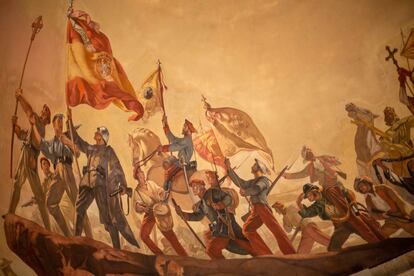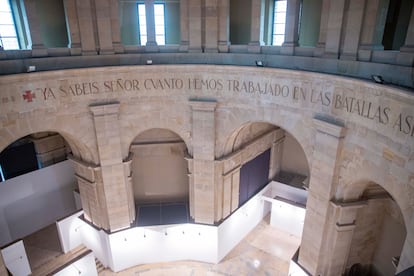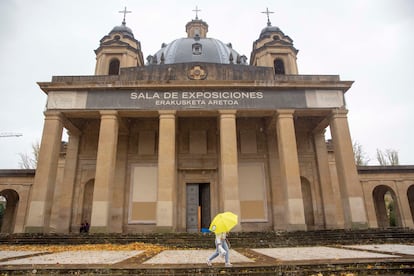The keys that open the Monument to the Fallen of Pamplona are small and are held by a simple, nondescript key ring. It is paradoxical that they open the enormous metal doors of the second largest monument of Franco’s exaltation in Spain after the Cuelgamuros Valley. The building, whose official name is Navarra a sus Muertos en la Crusade, closes off the city’s most important pedestrian thoroughfare and is surrounded by a large plaza and roughly similar-looking buildings. It has been closed for years and, inside, silence is the protagonist. You can only hear the fluttering of the pigeons that take refuge in the highest area, which is accessed by narrow stairs that show the effects of lack of use: excrement, cobwebs and some broken glass in the stained glass windows. Above, the large dome that marks the urban landscape of Pamplona.
It is decorated by a set of mural paintings of almost 700 square meters with which the academic Ramón Stolz wanted to represent Navarre’s commitment to the Crusade and the Catholic religion. The frieze that supports it reads in large letters – some still retaining an intense red color -: “You know, Lord, how much we have worked in the battles, as well as my brothers and my father’s house to defend our law and for the sanctuary… ( Book 1 Maccabees XIII, 3). In the lower part, the noble area, there are still the white panels that held the last exhibition held there and, on the walls, beige planks and black canvas cover the marbles with the names of the more than 4,500 Navarrese dead from the rebel side. after the coup d’état of ’36. A good part of these elements are going to disappear after the municipal political agreement reached by EH Bildu, Geroa Bai and PSN to redefine the building and turn it into a complaint center of fascism.
In the architectural field, the pact contemplates the demolition of the crypts in which the coup generals Emilio Mola and José Sanjurjo were buried until 2016. A “specific action” will be carried out on the exterior dome and the exterior arches and marbles on which the names of the dead rebels are inscribed will be demolished. Soltz’s paintings will be covered and “viewings restricted to educational, pedagogical and/or academic purposes” will be permitted.
The pact does not include a specific project, but rather calls on the City Council to organize a new contest of ideas that contemplates these bases. The Official College of Vasconavarro Architects has not agreed on an institutional opinion, but its president, Santiago Iribarren, believes “that the solution does not involve a new contest of ideas,” but rather through the resolution of the one already started a few years ago. “49 teams participated, seven projects were selected, it was interrupted due to an appeal already resolved and we consider that it should be finalized by declaring a winner. The opposite is a lack of respect.” Iribarren “is struck by the fact that symbolic intention is given to the dome” because he considers that “the greatest symbolic load of the building resides in its stairs and platforms, which give it a monumental character.”
Inside, the decision to allow restricted viewing of the paintings is fundamental for Marta Rodríguez Fouz (Coruña, 52 years old), professor of Sociology at UPNA, specialist in post-violence and researcher at I-Communitas: “The key is that have the dimension of recognition. It is not so much about forcing the way you have to look, but rather about eliminating everything that may have homage. It can be interesting as an element that shows the ways in which fascism is reproduced and symbolizes certain values.”

The political agreement also contemplates removing the building’s status as a monument and converting it into a center for denouncing fascism and for democratic memory that will be called Maravillas Lamberto, in honor of the 14-year-old girl who in 1936 was raped and shot by Falangists along with to his father. This new entity will collaborate with the Documentary Center and with the Oroibidea digital archive of the Navarro Memory Institute. Maider Maraña (Donosti, 43 years old), director of Baketik, an organization that promotes processes of social transformation and conflict resolution, thinks it is positive: “It goes from being a place of homage to a fascist ideology to being a center in which “question violence and honor the memory of the victims.” Maraña recalls that the United Nations recognizes the right to memory and considers that the political agreement has that objective, although he points out: “Institutions have the obligation to recover these spaces, but they have to create formulas to dialogue and make the voice of the people effective.” victims and survivors. It is not just about going to the place a few days a year or giving their testimonies, but it is even about generating shared decision-making mechanisms.” This is not usually easy, he acknowledges, “because the victims do not have just one voice, they do not always want the same thing.”

This is what has happened in Navarra, where this dialogue has been non-existent, says Amaia Lerga (Tafalla, 38 years old), president of the Association of Relatives of Those Shot in Navarre (Affna-36). Memorial associations have been demanding the demolition of the monument for years and are upset at having found out about the agreement through the media. What hurts the most, Lerga confesses, is that they use the name Maravillas. Josefina Lamberto, his sister, “expressed throughout her life a clear position in favor of the elimination” of this monument and now “the name of her relative has been used as a reference for a space that she wanted to throw away.” “This is not understanding what the victims or their families are saying,” he adds. “The memory of Josefina and Maravillas will be found sooner in any other grave, in any other space and place of memory, than in this building,” he determines. There is no unanimous opinion among the people belonging to these associations. At least thirty of them have signed a manifesto in which they are in favor of giving new meaning to the building, even if only “to unblock the debate.” They consider that “putting emphasis on the causes that made the coup uprising possible and that the Franco dictatorship endured from an anti-fascist vision” is a “historic step.” Of course, they insist on rejecting the declaration of this building as a place of memory.

There is still a long process for this project of resignification to materialize. In the coming weeks, the three groups will bring to the Navarrese Parliament a proposal to modify the regional regulations on historical memory – approved in 2013 – and change the conditions to lower the level of protection of the property. Once approved, the Pamplona City Council – owner of the building – will request to modify its level of protection and the General Directorate of Culture of the Provincial Government, through the Príncipe de Viana institution, will issue a mandatory report. Once the building is discontinued, work will begin on a specific project.
Who was Maravillas Lamberto?
In Navarra there was no war front. There was strong economic and social repression that resulted in more than 3,000 deaths and forced disappearances. Like that of Maravillas and Vicente. On August 15, 1936, at two in the afternoon, knocks sounded on the Lambertos’ door, in the town of Larraga. Two armed civil guards forced the father, Vicente, to accompany them. His daughter Maravillas, 14, wanted to go with her father to find out what they were doing to her. The next morning, the mother, Paulina, asked the couple’s other two daughters, ages 7 and 10, to go to the dungeon to bring them breakfast.
The little girl, Josefina, remembered decades later the conversation with a Falangist: “Your father no longer needs him. “Your father is no longer here.” Shortly afterward they learned that Maravillas had been raped repeatedly in the municipal jail and that father and daughter had been shot in a nearby area. They never found Vicente’s body and learned that a neighbor had burned Maravillas’ body after finding it partially eaten by dogs. When Josefina turned 87, in 2018, she gave her last interview in SER Navarra, where she recalled the pain she suffered: “They took everything from us, nothing more than out of envy.” His mother also went to prison and several neighbors took the opportunity to ransack their house. Josefina remembered that the neighbor who “took the mare and the wheat from them stood in the middle of the street shouting: We have to kill the little Chinese because the little Chinese are getting big!” Until her death in 2022, Josefina, founder of Affna-36, was one of the most recognized historical memory activists in Navarra. He was clear about what to do with the monument: “It’s horrible. Let them throw it away.”

